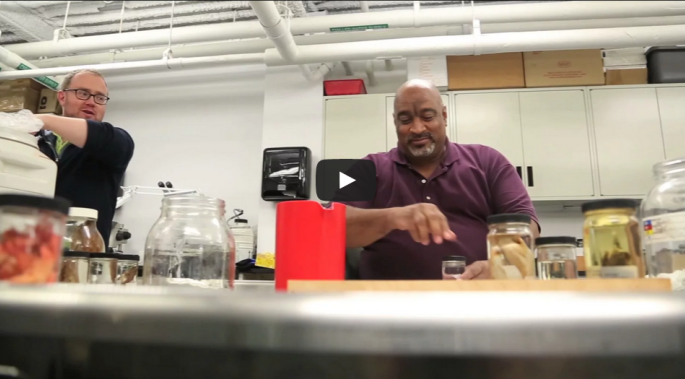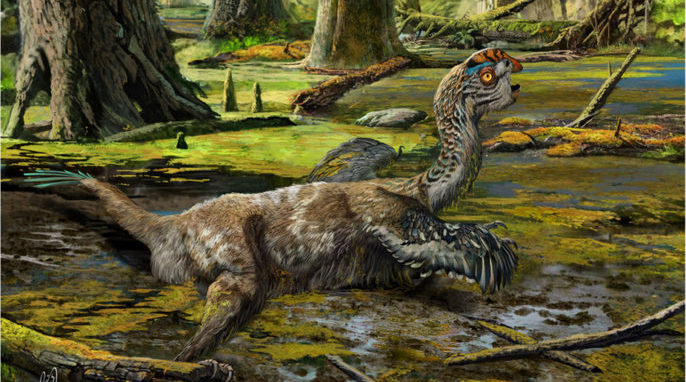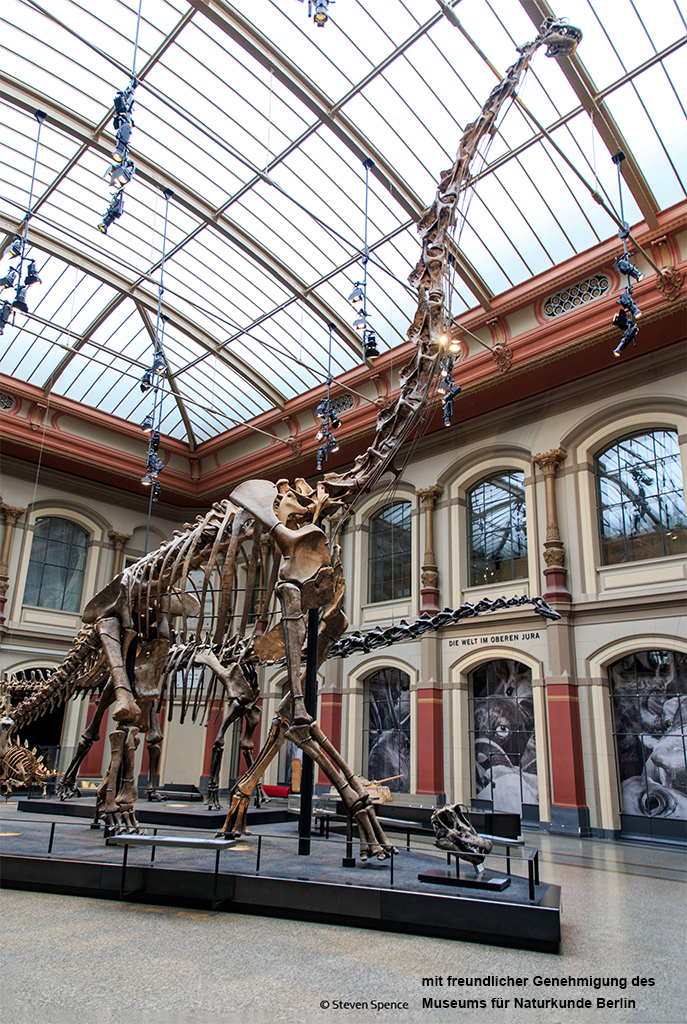For centuries, dinosaurs have captured the public’s imagination through their massive proportions and power, and their ancestral connection to birds has more recently brought a new fascination to paleontology. But when a newly discovered dinosaur is both huge and covered in feathers, it becomes the stuff of legend—a true dragon shaped by evolution instead of mythos.
Meet Dakotaraptor steini, one of the largest “raptor” dinosaurs known to science. This 17-foot-long predator was described by Robert DePalma, curator of vertebrate paleontology at the Palm Beach Museum of Natural History, and colleagues in last month’s Paleontological Contributions. Hailing from the Hell Creek Formation’s 66-million-year-old boneyards, Dakotaraptor would have shared its sub-tropical, floodplain environment with Triceratops, Edmontosaurus, and Tyrannosaurus rex, so it was by no means the largest animal stomping around late Cretaceous North America. But among its fellow dromaeosaurs—the family of bipedal, carnivorous dinosaurs typified by an enlarged “killing claw” on each foot and a close affinity to birds—its only competitor was the much older Utahraptor, which predated the Hell Creek ecosystem by about 60 million years.
The Thing with Feathers
As yet, there is no direct fossil evidence that Utahraptor, Deinonychus, and a number of other dromaeosaurs were feathered, because many of them come from depositional sediment where the preservation of delicate feathers is not possible. We can infer that they were certainly feathered based on fossils of their German and Chinese cousins, who had the good fortune (to us, anyway) to fossilize in fine-grain limestone and volcanic ash. These have given us a breathtaking detail of feather preservation in dinosaurs like Archaeopteryx, from Germany’s Solnhofen quarries, and Microraptor, from the famous Liaoning formations of northern China.
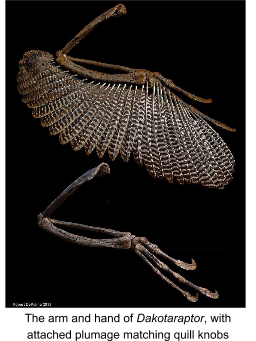
These animals (and many like them) don’t merely have feathers, they have a specific sort of feather seen today in flying birds: long, vaned, barbed feathers with strong central quills. Since these feathers are directly known from both early ancestors and late descendants of these dinosaurs, it is reasonable to assume that the whole tribe possessed them—the trait is ancestral to the entire group. This method of inference is known as phylogenetic bracketing, and it is based on the same logic we use to determine that prehistoric mammals, known only from bones, were likely covered in hair.
Bracketing is a robust method of inference when we have a lot of data points, and for dromaeosaurs we do. But most of these data points come from smaller, more obviously birdlike members of the family, and there’s always been an undercurrent of doubt as to whether the larger members of the family would have them, too. What would a dinosaur so large, the skeptics ask, need long, quilled feathers for? Why does something far too big to fly need the sort of feather ostensibly used for flying? Dakotaraptor hasn’t answered all of these questions for us, but it has given us one of the most important data points yet.
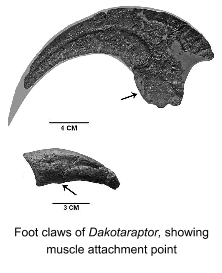
Like its much smaller Mongolian cousin Velociraptor, Dakotaraptor has huge, obvious quill knobs on its arms. Knobs like these are clear signs of ligament attachment points for big, strong feathers with robust quills. But while the turkey-sized Velociraptor could have derived some aerodynamic advantage from its wings, Dakotaraptor was bigger than a grizzly bear. No one knows for sure what it was doing with wings, but one thing is certain—it wasn’t flying.
The Dakotaraptor, its Form and Function
Dakotaraptor might have been around the same size as its Utahraptor great-uncle, but its body plan was very different. Where Utah was stout, low-slung and muscular, Dakota was tall and lithe, something like a scaled-up Deinonychus. The proportions of its legs and feet would have enabled it to run faster than its stouter relatives. Like all dromaeosaurs, it possessed two enlarged claws—one on the second toe of each foot, and held off the ground—and these were massive and powerful, with larger muscle-attachment points than in related species. Its hands are tipped with huge claws and its arms long and flexible. Every element of its anatomy suggests an active, carnivorous lifestyle.
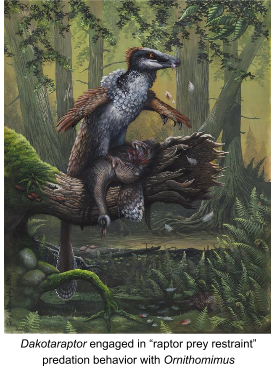
The large feathers on the arms of this giant dromaeosaur may offer further clues to its predatory behavior. Many different uses for arm-feathers in non-flying dinosaurs have been proposed, including the shielding of eggs during brooding, signaling for courtship, and aggressive territorial display. However, none of these functions require the amount of stress that large quill knobs imply. In living raptors—that is, hawks, falcons and eagles—prey is often struck with the feet, which show a curious similarity to those of dromaeosaurs. Birds of prey have massively enlarged talons on the second toe, as well as short ankles that provide the torque for squeezing the life out of their prey. The bird will hang on while standing atop its meal, wings outstretched for balance and protection as its weight bears down on those huge second-digit talons. So similar are the feet and legs of dromaeosaurs that paleontologist Denver Fowler has proposed a similar method for dispatching prey. This model, known as “raptor prey restraint”, is a likely explanation for the wings of Dakotaraptor: the sturdy quills would provide a balancing surface, and the strong arms a primitive flight stroke.
In its late Cretaceous ecosystem, Dakotaraptor’s size would have pitted it against a wide swath of competition from other predators. T. rex was considerably larger, with adults up to 40 feet in length, but tyrannosaurs are known to have complex growth stages and Dakotaraptor was almost certainly striving to dominate the same ecological niche as Tyrannosaurus juveniles. This would have set the giant raptor apart from Acheroraptor, the only other dromaeosaur known from the Hell Creek Formation. Acheroraptor was a coyote-sized little predator comparable to Velociraptor, and its much smaller prey would have made it largely ignorable to something the size of Dakotaraptor.
Dakotaraptor is known from several individuals that provided a collation of vertebrae, parts of the legs and feet, a complete arm and hand, and a number of scattered teeth. Some of the individuals these bones belonged to differed in size despite appearing fully mature, and this has led some researchers to speculate that Acheroraptor may actually be a smaller size morph of the same genus. Acheroraptor, however, is known only from a few pieces of the jaws, so the only overlap between material in the two dromaeosaurs is the teeth. While this makes direct comparison difficult, the teeth, at least, differ substantially: those belonging to Acheroraptor have strong and numerous serrations that the larger raptor lacks. Lead author DePalma is confident that the two are distinct, and has stated that “future fossil discoveries will no doubt reinforce the differences between the two taxa.”
That notwithstanding, there is much yet to be learned about this enormous dromaeosaur and its haunts and habits. As of yet we have no skull material and little from which to draw inference about social behavior, family structure, or life history. The use of its feathers, while offering some tantalizing possibilities, is still much a mystery. But such is the joy of paleontology—each new discovery answers some questions and opens many more, ripe for exploration by those who dare.
GotScience.Org translates complex research findings into accessible insights on science, nature, and society. For the latest science news subscribe to our science newsletter!


